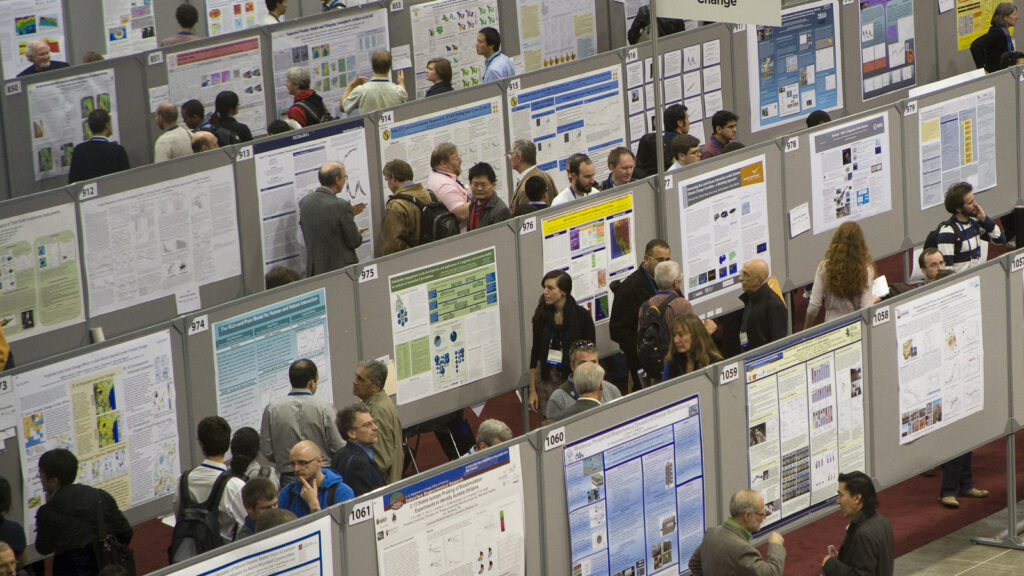Image source: NASA
By Zoha Deldar and Carlos Gevers-Montoro
COVID-19 has shaken our whole world upside down. Our minds are racing with stress and anxiety as we read the news, worry about our loved ones, and feel pressure to stay productive during this unusual time. Coping with this new situation is extremely taxing and resource-consuming, especially for early-career researchers, as we face increasingly unpredictable futures. As university life and research have ground to a halt, there is much uncertainty concerning upcoming vivas, finishing contracts and the status of grants. Since we have no idea when or whether we will be able to get back on track, 2020 could become a blank page in our CVs. Meanwhile, many of us are worried about how the indefinite closure of borders will affect our career paths since the international mobility that our careers are built on is currently impossible.
As junior scientists, we rely heavily on scientific conferences for early-career progression. These events provide unique opportunities to present and promote our research to other scientists in our fields, while offering invaluable occasions to network and forge collaborations. With all conferences having been cancelled indefinitely, we are suddenly being denied those opportunities, and feeling as though our hard work in preparing for them is going to waste is devastating. But in the midst of this turmoil, some positive outcomes can be found. Science, as it has always done, is adapting to this new environment, and some of the changes may just turn out to be for the better.
Most conference organizers have taken a rather proactive approach in responding to the challenges of this new scenario. Some organizations have decided to postpone their events to summer, fall, or as far as 2021. Others have managed to bring their events entirely online in record time, giving access to most of the programmed content to thousands of participants. These adaptations need to consider all aspects of scientific conferences, and as the format evolves, we are seeing innovation and creativity bloom in this field.
This crisis has unveiled how much of a privilege attending in-person scientific conferences is, and one that is not afforded to everyone. Remote participation in online meetings opens the door to citizens of countries where visa hassles and travel restrictions make attendance to international meetings prohibitive. Participation in virtual conferences is often much more affordable while travel costs can be brought down to zero, making them more inclusive as well. Events immediately become more accessible to people with physical disabilities and family responsibilities at home, who usually think twice before registering for events that require long-distance displacements. Even travel awards can be upgraded and turned into remote travel awards. For example the Open Bioinformatics Foundation encouraged everyone to avoid travelling as much as possible in order to slow the rate at which COVID-19 spreads to vulnerable people. In light of the current situation, the organizers opened the door to creative ideas for their last travel fellowship deadline, accepting applications from all over the world. Budgets were adapted to cover headsets, webcams, video conference platform fees, or any other tools that would increase the diversity and representation for remote conferences.
Reducing travel through virtual participation also has obvious benefits for the environment. As we have witnessed in recent weeks, confinement has led to side-effects like reductions in air pollution and wildlife venturing into empty cities. Similarly, stimulating online conferences offers an opportunity to reduce our own personal carbon footprint and the impact of scientific conferences as a whole on climate change. For science to be part of the solution, not the problem, we should start considering reducing flights and other ecologically-taxing travelling more seriously. Air travel makes up to 4% of total CO2 emissions globally, and we know that emissions are mostly caused by a small percentage of the world’s population. Researchers are no exception.
While forcing last minute changes in format, the current situation has also accelerated the development of events with a more open and sharing spirit. In the very early days of the pandemic, we witnessed an impressive effort by the Neuromatch Unconference. The organizers’ aim was to create a more inclusive, free, and open conference in the field of computational neuroscience. It was a massive success, as over 2000 people from all over the globe participated. Multiple parallel sessions were scheduled during the conference and attendees could choose which one to attend simply by clicking the Zoom link that had been announced along with the presenter’s abstract. Neuromatch also tried its best at providing essential networking opportunities like Mind matching sessions that automatically connected participants to groups with related areas of interest and by sharing job advertisements with trainees and professors.
Another recent example of a successful online conference format is the OHBM Equinox Brain Twitter Conference. Planned as an entirely online event long before the pandemic occurred, this conference featured both keynotes and research presentations, delivered through a series of tweets under the conference hashtag #OHBMx. Apart from providing all content for free, these types of conferences also promote open science. Anyone interested can participate by attending, asking questions and actively engaging in discussions. Inspired by this initiative, BrainWeb provides a virtual space for online collaborations on neuroscience research on a permanent basis.
It is becoming increasingly popular amongst conference organizers to make videos of all presentations immediately available free of charge, such as the machine-learning conference NeurIPS. Not only presentations, but also papers and posters submitted could easily be made available to researchers who can’t afford to travel and participate in person at the meetings. In response to COVID-19, this trend has only increased as education companies have started sharing their webinars, courses, books, and other information products for free. For instance, the San Diego Pain Summit Conferences decided to offer more than 60 hours of pain education and research for free, including citations and even the option to download handouts and slides of speakers who had previously authorized it. Hopefully, this trend will continue to facilitate both inclusiveness and openness of scientific meetings, even after the crisis is over.
In terms of scientific content, online events can reach similar standards as face-to-face conferences while also providing important advantages such as schedule flexibility and timing. However, there are other aspects of in-person conferences that are more difficult to replace. For many researchers, networking is the main motivation to attend conferences. Meeting, discussing, and befriending other scientists from around the world often leads to new collaborations, new ideas, and even job opportunities, and this might not be as easily achieved via virtual meetings. Indeed, when asked, senior researchers commonly point out serendipitous interactions that are difficult without casual face to face communication. These interactions provide an opportunity for trainees to interact with future collaborators and for professors to meet potential additions to their labs. These connections are invaluable and essential to the progress of many projects. We can’t simply ignore that in-person conferences give us an opportunity to meet old friends and make new ones, and potentially even find our next career steps.
The main challenge for virtual conferences therefore remains finding innovative ways to facilitate social and professional networking. Virtual meetings using platforms like Zoom or Webex could organize “meet and greet” sessions or virtual cocktail hours that allow people to introduce themselves and discuss shared interests at specific times. Some great tools that are already in place could be used to generate similar types of semi-casual interactions. Smart badges are used in traditional meetings to exchange information with exhibitors and alert attendees of people with common interests nearby who they might be happy to meet. The same algorithms could be easily applied to online conferences to help attendees mingle and connect with people they wouldn’t easily meet otherwise. However, it is unlikely that any algorithm or virtual communication platform will ever be able to replace the more casual, relaxed interactions that happen when grabbing a sandwich, sharing a drink or simply wandering around the hallways of a conference center. A great example of this is the story of how Cohen and Boyer started the collaboration that led to the development of the technology allowing to transplant genes from one living organism to another after a walk on the beach over lunch! Virtual conferences will never be able to fully replace in-person meetings, but they are certainly a great addition that have plenty to teach us.
The pandemic has given many of us more time to participate in online presentations, conferences, tutorials, and lab meetings than we normally would have, and all without even having to leave our rooms. The costs of constant conference travel are becoming unsustainably high, both for ourselves, our families, and even the environment. Our time and budget are limited, and we frequently have to choose which conferences to attend, missing out on great events every year, or even every month. Maybe in the future we will see a smaller number of in-person meetings, while much happens online and we participate remotely from the comfort of our homes. Although this new routine is obviously far from ideal, we should try to see the positive aspects and learn some lessons that may help to improve our practices moving forward when the lockdown is over. We should appreciate the organizers of online conferences for their open minds, their innovation, creativity and generosity in putting together these programs and bringing some hope during difficult times. Perhaps this extraordinary situation will encourage a shift towards a more open, inclusive, and sustainable format for future conferences. Although we don’t intend (or even hope) that the paradigm shift would make in-person meetings disappear, it could certainly help people choose if they would like to participate virtually or physically, and we look forward to our community becoming more and more global, diverse, accessible, and sustainable!





